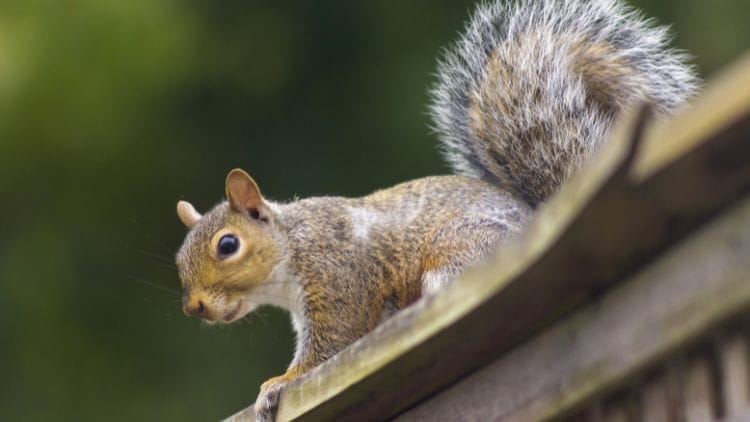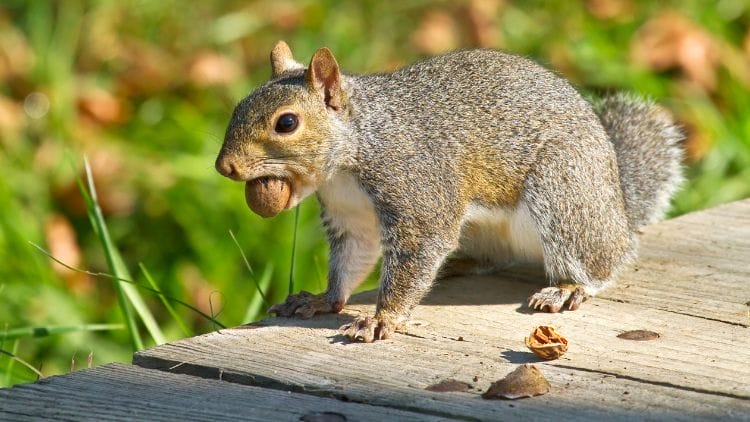Gray squirrels, also known as tree-climbing nut buriers, are familiar creatures with their scampering ways. These American imports have become a common sight in many areas.
If you are interested in learning Squirrel’s info about Squirrel Anatomy then click here.
However, their presence has brought disastrous consequences for the native red squirrel populations. Let’s delve into what makes these critters so fascinating and the challenges they pose.
What do grey squirrels look like?

Grey squirrels typically have predominantly grey fur, although they may display red-brown patches, particularly around their face and legs. They are characterized by a long, bushy tail that aids in their balance while climbing trees.
Not to be mistaken with a red squirrel. While coloration generally serves as a differentiating factor between these species, instances of reddish-grey and greyish-red squirrels can arise.
To ascertain identification, inspect the tail. Red squirrel tails display a consistent hue, whereas grey squirrel tails often exhibit a spectrum of shades, frequently accompanied by a white ‘halo’ along the perimeter.
Additionally, grey squirrels tend to be more robust, with an average weight of 550g, compared to the 300g typical of red squirrels.
What do grey squirrels eat

Grey squirrels are omnivorous creatures, meaning they consume a diverse diet consisting of both plant and animal matter.
Their diet commonly includes nuts, seeds, fruits, berries, fungi, and various types of vegetation.
Additionally, they may also feed on insects, bird eggs, and small vertebrates when the opportunity arises.
How do grey squirrels breed
Grey squirrels breed through a process that involves distinct breeding seasons. The first breeding season typically occurs from December to February, followed by a second season from May to June.
It’s noteworthy that during their first year of life, female squirrels are unable to breed. However, male squirrels exhibit high levels of activity during the breeding season.
Interestingly, these animals engage in intricate mating dances as part of their reproductive behavior.
Where do grey squirrels live
Originally native to the woodlands of North America, grey squirrels made their debut in the United Kingdom during the 19th century, introduced for ornamental purposes.
Since their arrival, they have acclimatized and thrived in their new environment, rapidly expanding their territory across the British Isles.
Although their presence is widespread throughout much of the UK, there are distinct regions where they are notably absent, including the northern and western reaches of Scotland, as well as certain isolated islands.
Despite these regional variations, the grey squirrel population in the UK has flourished, with estimates suggesting a staggering 2.7 million individuals. This substantial population is indicative of their adaptability and reproductive success in the British landscape.
Moreover, their numbers continue to show signs of growth, highlighting their resilience and ability to exploit available resources.
In urban and suburban areas, grey squirrels have become a familiar sight, often frequenting parks, gardens, and woodlands. Their presence is not only a testament to their ability to thrive in diverse environments but also a reminder of the complex interplay between human activity and wildlife dynamics.
Overall, the story of the grey squirrel in the UK serves as a fascinating case study in ecological adaptation and human-wildlife interactions.
From their humble beginnings as an introduced species to their current status as a ubiquitous presence in the British countryside, grey squirrels embody the resilience and adaptability of nature in the face of changing landscapes.
Signs and spotting tips
When it comes to observing wildlife in the UK, grey squirrels take the spotlight as one of the most conspicuous mammals.
Whether you embark on a stroll through a nearby woodland or leisurely explore a local park, the chances of encountering these agile rodents are exceptionally high.
Their presence is often heralded by the sound of rustling leaves and branches as they scamper across the forest floor or ascend tree trunks with remarkable agility.
Not limited to woodland habitats, grey squirrels also frequently venture into suburban and urban areas, making gardens prime locations for sightings, especially those adorned with bird feeders.
These furry foragers are quick to capitalize on any opportunity for a meal, and their acrobatic antics provide ample entertainment for attentive observers.
To enhance your chances of spotting grey squirrels, keep a keen eye out for their telltale signs, the flash of their bushy tails, the nimble movements as they navigate their surroundings, and their distinct chatter.
By honing your observation skills and remaining patient, you’re bound to enjoy numerous encounters with these charismatic creatures, adding a touch of wildlife magic to your outdoor adventures.
Threats and conservation
The introduction of grey squirrels to the United Kingdom has posed a significant threat to the country’s only native squirrel species, the red squirrel.
Grey squirrels not only compete with red squirrels for food resources but also act as carriers of a virus known as squirrel pox.
While grey squirrels themselves are immune to this disease, they serve as vectors, transmitting it to red squirrels, for whom it proves fatal.
Consequently, the presence of grey squirrels has played a substantial role in the decline of red squirrel populations across the UK. The few remaining viable populations of red squirrels are typically found in areas where grey squirrels are scarce or absent.
Moreover, grey squirrels can exert further ecological pressure by impacting the composition of native woodlands. Their habit of bark stripping and consumption of tree seeds can disrupt the natural regeneration of forests and compromise the overall health of woodland ecosystems.
To address these conservation challenges, efforts are underway in various parts of the country to manage grey squirrel populations.
Culling programs are implemented strategically to protect red squirrel populations and mitigate the adverse effects of grey squirrel presence on native ecosystems.
These conservation measures aim to restore balance to woodland habitats and safeguard the long-term viability of native squirrel species in the UK.
FAQ
How can I differentiate between grey squirrels and other squirrel species?
Grey squirrels are typically larger than other squirrel species and have predominantly grey fur with red-brown patches. Their bushy tails often have multiple shades and may display a white ‘halo’ around the edge, distinguishing them from other species.
Are grey squirrels native to the UK?
No, grey squirrels are not native to the UK. They were introduced from North America during the 19th century.
What impact do grey squirrels have on the environment?
Grey squirrels can have a detrimental impact on native ecosystems. They compete with native species like the red squirrel for food and habitat, and their feeding habits can affect the composition of native woodlands.
How do grey squirrels contribute to seed dispersal in forests?
A: Grey squirrels play a role in seed dispersal by caching nuts and seeds throughout their territory. Some of these caches are forgotten, allowing seeds to germinate and new plants to grow.
What measures are being taken to control grey squirrel populations?
Various control measures are employed, including culling programs and fertility control methods, to manage grey squirrel populations and mitigate their impact on native species and ecosystems.
Are grey squirrels aggressive towards humans?
Grey squirrels are generally not aggressive towards humans unless they feel threatened or cornered. In urban areas, they may become accustomed to human presence and may even approach people in search of food.
Do grey squirrels hibernate during the winter?
Grey squirrels do not hibernate but may become less active during the winter months. They rely on stored food and insulated dreys (nests) to survive the colder temperatures.
How long do grey squirrels live in the wild?
In the wild, grey squirrels typically have a lifespan of around 6-10 years, although some individuals may live longer under favorable conditions.
Can grey squirrels be kept as pets?
In some regions, it may be legal to keep grey squirrels as pets with the proper permits and licenses. However, they require specialized care and may not make suitable pets for everyone.
What diseases do grey squirrels carry?
A: Grey squirrels can carry diseases such as squirrel pox, which is fatal to red squirrels. They may also carry parasites and other pathogens that can affect humans and other animals.
Do grey squirrels have predators in the wild?
Yes, grey squirrels have natural predators such as birds of prey, foxes, domestic cats, and some larger mammals. However, their adaptability and agility help them evade many predators.
How do grey squirrels communicate with each other?
Grey squirrels communicate through a variety of vocalizations, including chirps, barks, and chatters, as well as through body language and scent marking.
Are there any legal protections for grey squirrels in the UK?
Grey squirrels are not protected by law in the UK, and various control measures are implemented to manage their populations and minimize their impact on native wildlife and ecosystems.


You May Also Read